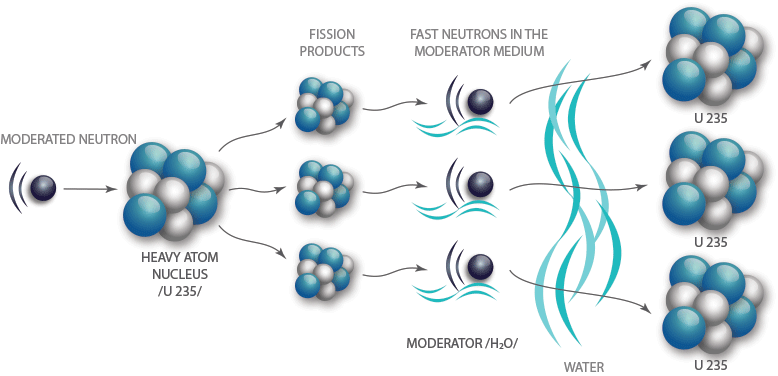THE PRINCIPLE OF TRANSFORMATION OF NUCLEAR POWER INTO ELECTRICITY

The chain reaction of heavy metals nuclear fission (uranium, plutonium, etc.) is used for the production of thermal power in the contemporary nuclear reactors, and then it is transformed into electricity.
In the slow neutron reactors, the nucleus fission is received as a physical interaction, from the collision of the delayed neutron with a heavy atom nucleus (uranium 235 nucleus). The collision splits the nucleus in fragments called fission products. This process results in the emission of fast neutrons and heat. After the power of the generated fast neutrons is decreased in the moderator (water), they collide with other heavy nuclei and the process repeats. This process is called "chain reaction", which is controlled by changing the number of slow neutrons. The heat, released during the process, is used to produce steam that drives the turbines, as in the conventional thermal power plants. In order to cool down the fuel and to delay the neutrons in WWER reactors, pure water is used as a coolant.
The material that interacts with the neutrons is nuclear fuel. At Kozloduy NPP, a slightly enriched uranium (3.6-4.4% of U 235, and approximately 96% of U 238) in the form of uranium dioxide is used as a nuclear fuel. It is manufactured in the form of pellets placed in small, tightly sealed "tubes" made of zirc aloy, so that the uranium fuel and the fission products have no direct contact with the coolant. These "tubes" are called fuel rods, and the bundles they form are called assemblies. A WWER 440 assembly contains 126 fuel rods about 2.5 m long, while their number for WWER 1000 is 312 fuel rods about 3.8 m long.
The controllable fission chain reaction is implemented in the reactor, in the so-called "core".
TECHNOLOGICAL DIAGRAM OF A PRESSURIZED WATER REACTOR NPP
The principle diagram of a pressurized water reactor NPP has two circuits. This concept is favorable in terms of preventing the dispersing of radioactive substances, as there is no mixing of water from the two circuits. The entire primary circuit equipment is installed in pressurized compartments, where, by suction ventilation systems, the pressure value is maintained below the atmospheric one. Thus, the possibility of uncontrolled flowing of contaminated air to the other plant compartments and the environment is prevented.
The primary circuit is used for removing the heat, generated in the reactor core and transferring it to the secondary circuit.
The primary circuit most significant components are the reactor, main coolant loops, pressurizer, relief tank and pressurizer safety valves.
The nuclear fuel, in the form of fuel assemblies, is placed in the reactor core. The primary circuit water circulates among the assemblies. It removes the thermal power generated during the nuclear reaction.
There are six main coolant loops for WWER 440, and four for WWER 1000.
The secondary circuit which is nonradioactive, is designed to take the thermal power from the primary circuit and to transform it into kinetic power of the steam turbine rotation. This energy is converted into electricity in the generator, thus the high effectiveness of the process being provided. By means of a switch-gear, the electricity is transferred through the grid to the consumers.
The secondary circuit, includes: steam generators (steam generating section), main steam lines, turbine generators (two of 220 MW for each WWER 440 unit and one for the WWER 1000 units), condensers and condensate heating systems.

Each coolant loop includes:
- Reactor Coolant Pump (RCP), forces the coolant circulation through the core;
- Main Isolation Valves (only for WWER 440), isolate each coolant loop;
- Steam Generators. The Primary coolant washes the steam generator tubes, thus heating and turning the secondary circuit water into steam.
The steam, generated in the steam generators, is collected in a general steam header and is directed to the turbine.
The water from the Danube river is used to cool down the condensers, and it runs through a third coolant circuit and has no contact with the water from the primary circuit. The water is sent via channels from the Bank Pump Station of Kozloduy NPP to the plant. Further, the pumps of the Circulation Pump Station feed the water into the turbine condensers.
The reactors of WWER (PWR) type are the most widely used worldwide.
